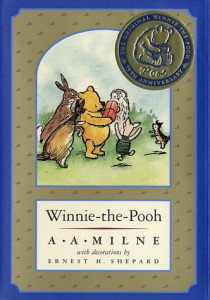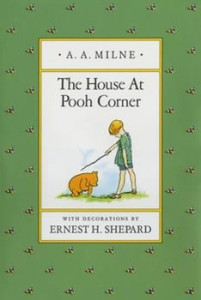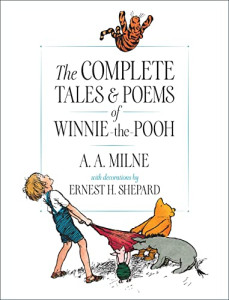 Pooh, like seemingly everything else, has been Disneyfied. The process actually started when I was a lad in the 1960s, with the short film Winnie the Pooh and the Blustery Day. Sadly, that was my introduction to Pooh, and I suspect it and the many other animated Pooh products that have rolled off of the assembly line since then are all that is known of these stories by succeeding generations. (I say “sadly” not because I didn’t enjoy it at the time, but because I had not previously been introduced to the stories of Pooh through the books.)
Pooh, like seemingly everything else, has been Disneyfied. The process actually started when I was a lad in the 1960s, with the short film Winnie the Pooh and the Blustery Day. Sadly, that was my introduction to Pooh, and I suspect it and the many other animated Pooh products that have rolled off of the assembly line since then are all that is known of these stories by succeeding generations. (I say “sadly” not because I didn’t enjoy it at the time, but because I had not previously been introduced to the stories of Pooh through the books.)
I didn’t discover the books until I was in high school. I learned that my girlfriend and her friends were big fans of the Pooh books, and since I was good at doing voices, they liked to have me read them the stories. I was only too glad to oblige, and along the way discovered how charming the original stories were. The films are good in their own way, of course, but the books are classics.
 Most everybody knows that Milne, a well-known English pacifist, wrote these stories and poems for his son, Christopher Robin Milne. In fact, with all the Milne and Pooh scholarship of the past few years, many people probably know more about it than I, so I won’t take a chance on embarrassing myself with any further background.
Most everybody knows that Milne, a well-known English pacifist, wrote these stories and poems for his son, Christopher Robin Milne. In fact, with all the Milne and Pooh scholarship of the past few years, many people probably know more about it than I, so I won’t take a chance on embarrassing myself with any further background.
Dutton released these three gorgeous editions to mark the 75th anniversary of the first publication of Winnie-the-Pooh. They come complete with the original illustrations (or “decorations” as it says on the covers) by Ernest H. Shepard. The drawings depict the characters – Pooh, Piglet, Kanga and Roo, Eeyore, Rabbit and of course Tigger – interacting with each other and with Christopher Robin, a rather dainty looking child in shorts, with a blonde Prince Valiant haircut. All of the animals, except Rabbit and Owl, are obviously stuffed animals, and will be recognizable to children as such.
The two separate Pooh books are lovely slim volumes with black-and-white drawings and gold- or silver-edged pages, the perfect size for young (though not too young) readers. And the third book is a hefty family-size volume just right for taking down from the shelf for nightly out-loud readings. It comes with full-color illustrations, including an utterly charming bee that points at the number on the bottom of each page.
What’s to attract children to the stories of Edward Bear, a.k.a. Winnie-the-Pooh, in this age of Pokemon and Playstations? The sheer joy of the language, for one thing. Milne sprang from the English tradition of nonsense and absurdity that also gave us Lewis Carroll’s masterpieces, as is clear from just about any of the poems in When We Were Very Young and Now We Are Six, included in The Complete Tales & Poems. This one, for example: “Lines and Squares.”
Whenever I walk in a London street,
I’m ever so careful to watch my feet;
And I keep in the squares,
And the masses of bears,
Who wait at the corners all ready to eat
The sillies who tread on the lines of the street,
Go back to their lairs,
And I say to them, “Bears,
Just look how I’m walking in all of the squares!” …
I’ll bet you’d never read that one, had you? Neither had I. It’s a good argument for getting The Complete Tales & Poems. You get such nimble, entertaining verse,  plus the familiar tales of heffalumps and jagulars and honey pots and haycorns and games of pooh-sticks. The stories themselves are told in clear language that will be understandable to even quite young children, but never talks down to them. There may be a few British usages that adults may need to explain, but not many.
plus the familiar tales of heffalumps and jagulars and honey pots and haycorns and games of pooh-sticks. The stories themselves are told in clear language that will be understandable to even quite young children, but never talks down to them. There may be a few British usages that adults may need to explain, but not many.
I especially like the stories in Pooh Corner in which Tigger is introduced, and later, when Rabbit cons Pooh and Piglet into trying to “de-bounce” Tigger. The first speaks to that experience most children have of being the new kid on the block and making new friends. The second teaches a good lesson about accepting each other the way we are, and not trying to change our friends to make them more like us.
The lessons come gently, though, amid a lot of wit and whimsy. Highly recommended for kids of all ages, even the adult ones.
(Dutton, 2001)
